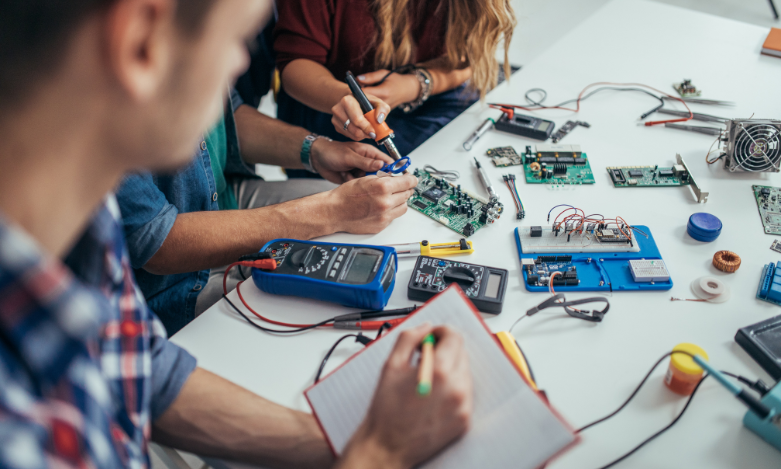CompactRIO Enables Undergraduate Power Electronics Education
- Nov 6
- 3 min read
*As Featured on NI.com
Original Author: Mats Alaküla, Lund Univerisity
Edited by: Cyth Systems

Project Summary
Lund University integrated the NI CompactRIO into its power electronic lab, teaching students real-time power electronics with research-grade systems.
System Features & Components
Real-time operating system (RTOS) enabled speed control and PID optimization
FPGA-level logic enabled implementation of hysteresis bounds and the simplification of overall system architecture
Live data visualization and parameter adjustment enabled through HMI
Outcomes
Achieved “fast computer” model levels of determinism, enabling real-world levels of system responsiveness
Reliable control loop execution delivers continuous live monitoring
Equipped undergraduate students with hands-on experience using research-grade control systems
Technology at-a-glance
Hardware:
NI cRIO-9063 chassis
NI cRIO-9038 chassis
Software:
LabVIEW FPGA
LabVIEW Real-Time
Control Theory in Practice
In university electrical engineering labs, students learn how motor drives and power electronics operate. These types of systems require microsecond-level precision to ensure continuous and smooth operation of motors.
For educators, it can be a challenge to bridge the gap between theoretical “fast computer” models and real-world control systems that introduce computational delays. At Lund University in Sweden, they needed to address this education gap needed to ensure their students could experience firsthand how control theory performs in a real-world context.
Determinism Requirements
Professor Mats Alaküla needed to teach students how to control electrical motor drives and power electronics systems with sub-milisecond time constraints. Maintaining currents within safe operating limits require voltage controll within hundreds of microseconds. Their existing MATLAB/Simulink and DSpace technology platform could not keep pace with modern electrical drives requiring increasingly higher frequencies. The Windows-based monitoring system interfered with control, disrupting the simulation of a realistic control system. The majority of students’ time was spent creating workarounds for hardware limitations, not mastering control algorithms themselves.
Lund University needed a solution that would prepare their students for the real-world scenarios they would encounter in ther future careers.
Hysteresis Control Enabled
The university chose to adopt the NI CompactRIO platform, paired with LabVIEW Real-time and FPGA Modules to implement a control architecture that would eliminate computation delays.

System Architecture & Capabilities
FPGA-based current control: time-critical electrical current control implemented directly on the FPGA
Real-time processing: slower control loops, for ensuring optimal system performance, run on real-time operating system (RTOS), including engine speed trajectory following and continuous PID parameter recalculation
Windows OS: live data visualization and datalogging enabled through user interface housed on the Windows OS
Integrated resolver signal processing: cRIO I/O availability and measurement speed capabilities eliminated the need for dedicated resolver circuits
Hysteresis control capability: FPGA measurement speed enabled direct current control with real-time three-phase current visualization in real-imaginary planes
Sub-100 microsecond voltage control: implemented on FPGA and RTOS to maintain current within acceptable intervals required by electrical drives
The responsiveness of the cRIO enabled the implementation of control methods that their previous solution couldn’t support. Direct current control via hysteresis required high determinisim to keep current within precise tolerances.

Traditional rotor position measurement requires high-frequency input signals and additional processing circuits. The measurement speed and I/O flexibility of the NI cRIO platform were capable of directly handling resolver signal processing and simplifying the system architecture students interact with.
The self-contained nature of the cRIO, paired with its ability to push live updates to host computers eliminated the Windows OS interference problems that previously disrupted control loops.
Real-World "Fast Computer"
The architecture enabled by the technology platform eliminated the gap between theory and practice for these students, as the solution responds as theoretical “fast computer” models would, making control theory directly applicable to real-world systems.
Lund University’s introduction of the NI CompactRIO platform to undergraduate students enabled continuity and best practice sharing with graduate students already using the platform for advanced electrical machine development.
The university is now fully capable of preparing their students for their future careers by enabling them to gain hands-on experience with the optimal control strategies driving the pace of development in modern power electronics engineering.
Original Author:
Mats Alaküla, Lund Univerisity
Edited by: Cyth Systems


